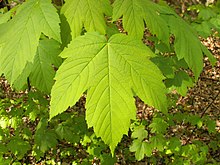| Maple Temporal range:
| |
|---|---|

| |
| Acer pseudoplatanus (sycamore maple) foliage | |
| Scientific classification | |
| Kingdom: | Plantae |
| Clade: | Tracheophytes |
| Clade: | Angiosperms |
| Clade: | Eudicots |
| Clade: | Rosids |
| Order: | Sapindales |
| Family: | Sapindaceae |
| Subfamily: | Hippocastanoideae |
| Genus: | Acer L. |
| Species | |
|
See either | |

| |
| Distribution | |
Acer is a genus of trees and shrubs commonly known as maples. The genus is placed in the soapberry family Sapindaceae.[1][2] There are approximately 132 species, most of which are native to Asia,[3] with a number also appearing in Europe, northern Africa, and North America. Only one species, Acer laurinum, extends to the Southern Hemisphere.[4] The type species of the genus is the sycamore maple Acer pseudoplatanus, one of the most common maple species in Europe.[5] Most maples usually have easily identifiable palmate leaves (with a few exceptions, such as Acer carpinifolium, Acer laurinum, and Acer negundo) and all share distinctive winged fruits. The closest relative of the maples is the small east Asian genus Dipteronia, followed by the more widespread genus Aesculus (buckeyes and horse-chestnuts).[1] Maple syrup is made from the sap of some maple species. It is one of the most common genera of trees in Asia. Many maple species are grown in gardens where they are valued for their autumn colour and often decorative foliage, some also for their attractive flowers, fruit, or bark.[6]
- ^ a b Joyce, Elizabeth M.; Appelhans, Marc S.; Buerki, Sven; Cheek, Martin; de Vos, Jurriaan M.; Pirani, José R.; Zuntini, Alexandre R.; Bachelier, Julien B.; Bayly, Michael J.; Callmander, Martin W.; Devecchi, Marcelo F.; Pell, Susan K.; Groppo, Milton; Lowry, Porter P.; Mitchell, John; Siniscalchi, Carolina M.; Munzinger, Jérôme; Orel, Harvey K.; Pannell, Caroline M.; Nauheimer, Lars; Sauquet, Hervé; Weeks, Andrea; Muellner-Riehl, Alexandra N.; Leitch, Ilia J.; Maurin, Olivier; Forest, Félix; Nargar, Katharina; Thiele, Kevin R.; Baker, William J.; Crayn, Darren M. (2023-03-07). "Phylogenomic analyses of Sapindales support new family relationships, rapid Mid-Cretaceous Hothouse diversification, and heterogeneous histories of gene duplication". Frontiers in Plant Science. 14. Frontiers Media SA. doi:10.3389/fpls.2023.1063174. ISSN 1664-462X. PMC 10028101. PMID 36959945.
- ^ Stevens, P. F. (2001 onwards). Angiosperm Phylogeny Website. Version 9, June 2008 [and more or less continuously updated since]. http://www.mobot.org/MOBOT/research/APweb/.
- ^ Xu, Tingzhi; Chen, Yousheng; de Jong, Piet C.; Oterdoom, Herman John; Chang, Chin-Sung. "Acer". Flora of China. Vol. 11. Retrieved 27 May 2012 – via eFloras.org, Missouri Botanical Garden, St. Louis, MO & Harvard University Herbaria, Cambridge, MA.
- ^ Gibbs, D. & Chen, Y. (2009) The Red List of Maples Archived 2019-05-28 at the Wayback Machine Botanic Gardens Conservation International (BGCI) ISBN 978-1-905164-31-8
- ^ van Gelderen, C. J. & van Gelderen, D. M. (1999). Maples for Gardens: A Color Encyclopedia ISBN 978-0-585-25457-9
- ^ [1] Crowley (2020) Acer L. from the website Trees and Shrubs Online